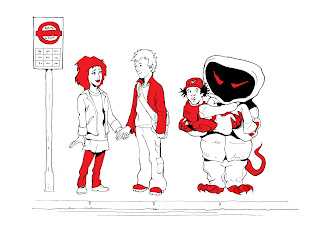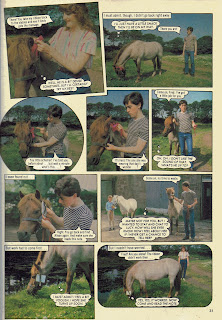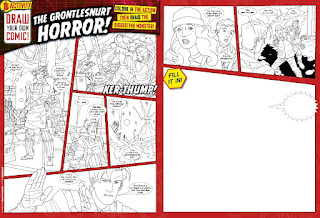To the
BFI Southbank last night to see
Coraline in eye-popping 3D. Eye-popping then replacing with buttons…
Coraline Jones moves to an old pink house in the middle of nowhere. While her parents are enslaved to their keyboards and deadlines, Coraline starts to explore. There’s the deep, deep well up the hill, the amazing mouse-circus ringmaster (Ian McShane) who lives upstairs, and the two mad old actresses (French and Saunders) living in the basement. And in Coraline’s own living room there’s a small door. Which leads to another old pink house where everything’s the same but much better… At least that’s how it seems at first.
It’s a wild ride, packed with jokes and scares and cleverness. Apart from a bit with a needle, the 3D is used sparingly to add texture to scenes rather than being all in your face. The Dr suspected you wouldn’t lose much without it, but I think the fact you’re not overtly conscious of the effect is really one of the film’s strengths. As with any special effect, the best ones are when you don’t notice it’s a trick.
That’s important because I assume the 3D is there as a hook to get people into cinemas and not squirreling pirate versions to watch on widescreen almost-cinema TV. It’d be easy to go overboard and showy.
There was a lively Q&A afterwards with
Neil Gaiman (what wrote
the book the film’s based on),
Henry Selick (what adapted and directed it) and
John Hodgman (voice of the Father and Other Father, and off the Daily Show and Flight of the Conchords). I liked that Selick started wary with his answers for fear of giving us spoilers.
Apparently Gaiman sent Selick the book long before it was published – and even before
illustrator Dave McKean got to see it – having loved his previous work. That means the film has been in gestation for something like nine years. Also, Gaiman’s note on an early version of the script was that it was too faithful an adaptation. It’s a while since I read the book, but the film seems bigger, more visual, less inside Coraline’s own head. There are more set pieces and principal characters.
Answering a question from the audience, Gaiman explained that there are things you can do in a book which just don’t translate to the screen. If he describes the Other Mother as “not-quite-the-same” as the real one, the reader does all the work in realising the difference. Selick has got to realise his own vision, show us what she looks like.
But I also think a book, or a narrated story, means you’re much more inside the protagonist’s head, and the tension and excitement is as much from what they’re thinking. In film you’re rarely privy to a character’s thoughts – telling us what they’re thinking is cheating. As viewers, we stand outside the action, our emotions plucked by action not thoughts.
In book and film Coraline struggles to make herself listened to; even a boy her own age in the film doesn’t give what she says any heed. That creates problems where you’d normally smuggle exposition into the dialogue.
Gaiman says the staged version has faced the same problem, with their Coraline saying as dialogue much more of the descriptive bits of the book. If I remember by A-levels correctly, there are dramatic conventions for this sort of thing. This isn’t cheating, though there are dramatic conventions for a character addressing the audience directly. A soliloquy speaks the truth – or at least the truth as the character sees it.
I don’t think Coraline narrating more of the film would have worked. It would have placed us self-consciously outside the action, at a distance and safe from anything that befalls her. As it is, we’re right up there with her, experience things as she does, part of the 3D world ourselves.
It certainly draws you in; the Dr – the wuss puss – found a lot of it scary. Gaiman said he’s interested in the response in the UK since things like the
New York Times review of Coraline dwelt on justifying the very idea of kids’ film being scary. Almost as if, said Gaiman, he was pushing “porn for kids”. Over here, he went on, we know full well that the best telly is watched from behind the sofa (he then body-swerved a question on whether he’d be writing Doctor Who).
It’s difficult judging how scary you can be: Coraline makes monsters from familiar sureties like your parents and friends and neighbours. Coraline’s own house and bedroom and dolls are warped into nightmares. Yet at the same time it’s colourful and fun, Coraline helped along the way with good and true friends, embracing the strangeness of the real world while battling the monsters.
The child who is not listened to reminded me a little of
David McKee’s Not Now, Bernard. Being careful what you wish for is the basis for many a scary fairy tale. Yet the child’s vivid imagination reworking the world around them is a bit like
Pan’s Labyrinth – a film Gaiman himself admits
wasn’t always suitable for a 12 year-old. Just because something is told through the eyes of a child doesn’t mean it is for kids.
Having tried to
write scary stuff myself, and struggled to get that balance right, I’m fascinated by this kind of thing (see
Scott on his three year-old’s response to Primeval). Just as with grown-ups, different kids will accept and engage with different things. One man’s meat is another’s monster. There’s stuff I was terrified of as kid (Worzel Gummidge, David Collings as Mawdryn…) that I knew at the time no one else was scared of…
It’s good that kids’ stories challenge and scare them, and that they overcome those fears. I guess the trick is in ensuring – trying to ensure – that you challenge, not abuse.







































